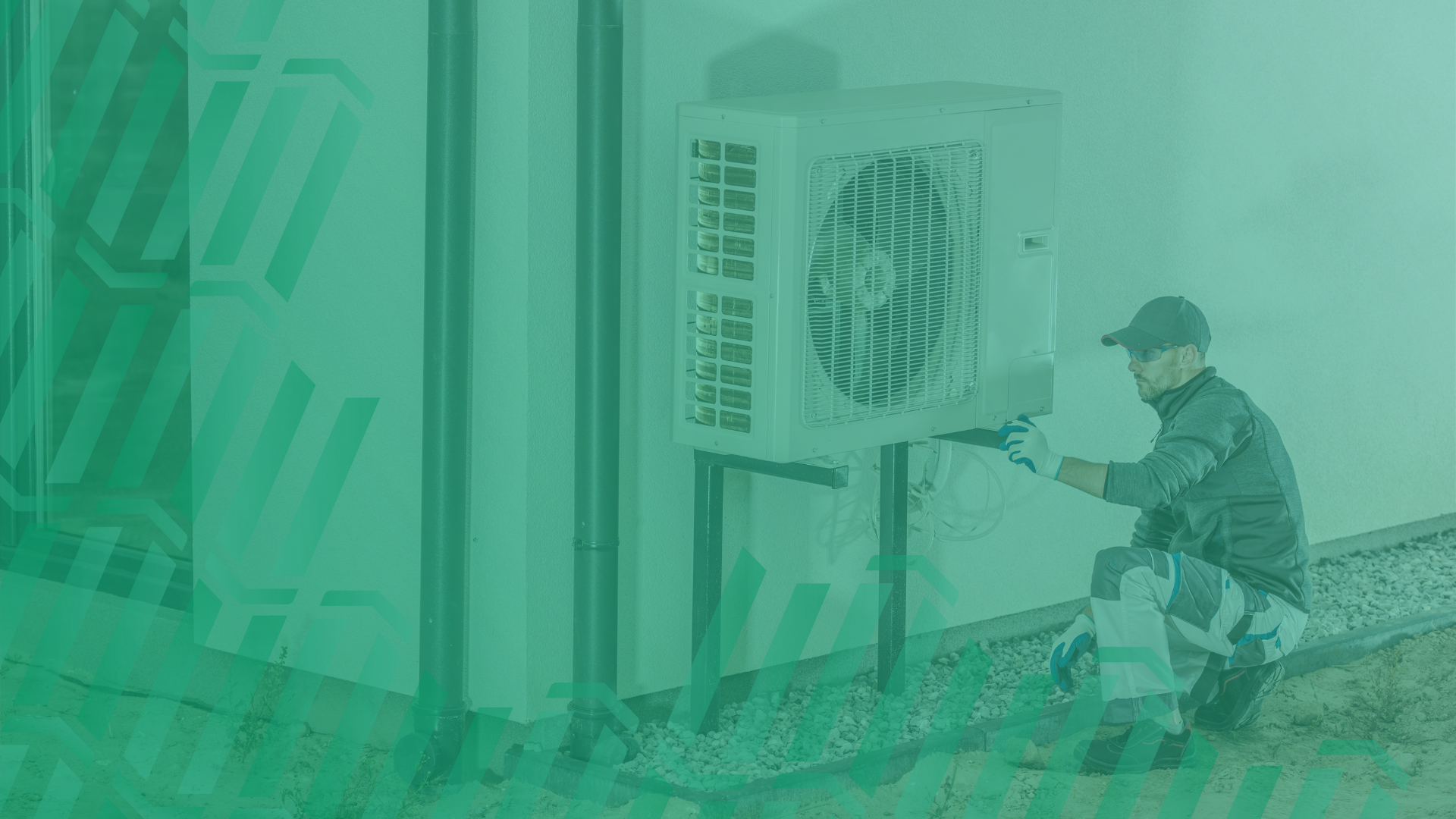Heat Pump Installation: 10 Key Steps for Success
December 4, 2024 | Read: 9 minutes

The UK is witnessing a surge in renewable energy adoption, and the installation of heat pumps is playing a significant role in the country’s adoption of sustainable energy systems.
While this is good news for the planet, it’s also means promising opportunities for plumbing and heating businesses, too…
If your business is interested in pursuing renewable installations and providing eco-friendly heating solutions for your customers, then understanding more about the heat pump installation process is crucial.
This blog offers installers a straightforward guide to cover the core steps involved with heat pump installation: right from the initial customer inquiry through to post-installation maintenance. The 10 steps below provide a useful overview of the basics you need to know.
From working closely with your customers, to meeting important regulatory standards, let’s explore the steps involved in achieving a successful heat pump installation.
Keep in mind you can download our infographic: it’s a short summary of all the steps you’ll find here, complete with objectives, and key actions, too!

Understanding Heat Pumps
Heat pumps are an innovative solution for heating and cooling homes efficiently. They work by extracting heat from the air or ground and transferring it indoors. Unlike traditional heating systems, heat pumps use renewable energy sources, making them environmentally friendly and cost-effective.
Understanding the mechanics of heat pumps is essential for installers. They need to know how these systems operate to convey their benefits effectively to customers. With government incentives promoting renewable energy, the demand for skilled installers is on the rise, too.
To ensure successful installation, installers must be well-versed in the technical aspects and regulatory requirements. This knowledge not only enhances credibility, helping you create more useful sales proposals for your customers, but assures them that they are investing in a sustainable and efficient solution.
Ground-Source and Air-Source Heat Pumps
Before we dive in, it’s worth mentioning that you may encounter requests for both ground-source and air-source heat pumps. While determining which to install will depend on factors such as the customer’s property, preference, and expertise of your engineers, the steps covered below will largely be the same, regardless of source type.
Ground-source heat pumps use the earth’s consistent temperature as a heat source or sink, require specific installation techniques such as borehole drilling or trench digging.
Air-source heat pumps draw heat from the ambient air outside the home (or draw warm air from within a home to cool it) and are placed on the outside of a customer’s property.
A site survey is essential in both cases to determine where’s best to place a heat pump, and installers can use software to help them make informed decisions about how best to meet their client’s needs. Ultimately, it’s about considering the conditions in order to optimise the installation’s effectiveness and performance.
10 Steps involved in a Heat Pump Installation
This overview will help you consider everything required to successfully install and maintain a heat pump. Let’s take a look:
Step 1. Customer Inquiry & Consultation
Building trust with potential customers is the first step in heat pump installation. During the initial inquiry, installers should schedule a meeting to discuss potential solutions and address any concerns.
The consultation is an opportunity to demonstrate industry expertise. By offering expert guidance, customers can feel reassured about their decision to invest in a heat pump. Installers should listen actively to understand customer needs and property details and offer advice.
Effective communication during the consultation builds confidence and sets the tone for the entire process. It’s an opportunity to showcase the benefits of renewable energy and position your business as more than an installer, but as a trusted advisor.
Step 2. Conducting a Site Survey
The site survey is a critical step in evaluating the property’s suitability for a heat pump. Installers should inspect the location, space, and infrastructure to ensure compatibility. This assessment helps tailor solutions and anticipate potential challenges.

During the survey, it’s important to consider factors like property size, insulation, and existing heating systems. These elements influence the choice of heat pump and its effectiveness in the given space.
A thorough heat pump site survey not only aids in selecting the right system but also identifies any necessary modifications. This proactive approach prevents delays and ensures a smooth installation process.
Step 3. Building a Comprehensive Proposal
Once the site survey is complete, it’s time to build a detailed proposal for the customer. This document should outline heat pump options, costs, and installation timelines. A clear proposal fosters transparency and builds customer confidence.
By presenting a well-structured plan, installers can address any concerns and highlight the benefits of each option. It’s essential to include information on energy savings, environmental impact, and long-term cost benefits.
A comprehensive proposal not only aids in decision-making but also sets realistic expectations. This clarity is crucial for maintaining a positive customer relationship throughout the installation process.
Step 4. Selecting the Right Heat Pump
Choosing the correct heat pump is a pivotal decision. Installers should recommend options based on the site survey results. Factors like energy savings, cost benefits, and customer preferences should guide this choice.
Focusing on the value proposition is key. Highlight the system’s efficiency, durability, and potential savings on energy bills. This approach showcases the long-term benefits of investing in a heat pump.
By aligning the system choice with customer needs, installers can ensure satisfaction and optimise performance. This selection process is a testament to the installer’s expertise and commitment to quality service.
Step 5. Applying for Funding/Incentives
Reducing customer costs through available programs is a valuable service. Installers should guide customers through the application processes for rebates or incentives. This assistance enhances the overall service value.
Many government initiatives support renewable energy adoption, such as the Boiler Upgrade Scheme (BUS). By helping customers access these funds, installers can make heat pump installation more affordable and attractive.
Providing information on available incentives not only boosts customer satisfaction but also promotes the wider adoption of renewable technologies. This proactive approach positions the installer as a knowledgeable partner in the transition to sustainable energy.
Step 6. Collaborating with DNO and MCS
Compliance with regulatory standards is non-negotiable. Installers must ensure they coordinate with the Distribution Network Operator (DNO) to verify grid compatibility and secure necessary permits. Additionally, submitting applications for the Microgeneration Certification Scheme (MCS) package certifies the installation’s quality and efficiency.
Early engagement with the DNO and MCS prevents delays and ensures that the installation meets all legal and professional standards. This collaboration is crucial for maintaining the integrity of the installation process.
By adhering to these regulations, installers protect their reputation and guarantee customer satisfaction. It also ensures that the heat pump operates efficiently and safely within the existing infrastructure.
Step 7. Preparing the Installation Site
Proper preparation of the installation site is essential for a smooth process. Installers should clear the area and ensure all tools and materials are ready. This step minimises disruptions and streamlines the installation.

Preparation involves more than just physical readiness. It includes confirming that all permits are in place (as discussed) and that the customer is informed about the installation schedule.
By prioritising preparation, installers can avoid unnecessary delays and maintain a professional work environment. This attention to detail sets the stage for successful heat pump installation.
You can manage every stage of an installation with Commusoft’s Job Management Software.
Step 8. The Installation Process
During the installation, following guidelines meticulously is crucial. Precision in installation ensures optimal performance and longevity of the heat pump. This stage requires technical expertise and attention to detail. Mistakes can be costly, particularly for ground-source heat pumps where partially buried systems will need to be re-dug, should there be any issues.
Installers should work systematically, ensuring that all components are correctly fitted and functioning. By adhering to best practices, installers demonstrate their commitment to quality. This diligence not only optimises system performance but also builds customer trust in the installer’s abilities.
Step 9. Testing the System
Once the heat pump is installed, conducting comprehensive tests is vital to verify the system’s functionality and efficiency. Installers should adjust settings as needed to ensure optimal operation.
Testing provides an opportunity to document results for future reference. This documentation reassures customers and serves as a valuable resource for ongoing maintenance.
By taking a thorough approach to testing, installers can address any issues promptly, ensuring customer satisfaction and long-term system performance.
Step 10. Post-Installation Follow-Up
Maintaining customer satisfaction and system performance doesn’t end with installation. Installers should address any customer queries and offer maintenance tips. Ongoing support can lead to referrals and long-term customer relationships.
Follow-up interactions are an opportunity to reinforce the benefits of the heat pump and provide additional value. By offering expert advice, installers can cement their status as trusted partners.
Building strong customer relationships is key to business growth. By providing exceptional post-installation support, installers can secure repeat business and valuable referrals.
Managing Heat Pump Sales with Commusoft:
With Commsoft, you can handle a lot of steps, in a stream-lined way.
Installing a heat pump involves more than just technical expertise; it requires clear communication, regulatory compliance, and a commitment to customer satisfaction.
By following this structured approach, installers can ensure a successful installation process that maximises the benefits of renewable energy. To help take things further and simplify managing these projects, it’s well worth exploring renewable energy software, like Commusoft, too. With our all-in-one system, you can simplify admin workflows, handle proposals with ease, and wow customers at evert turn.
For more detailed information on heat pump installations, download our comprehensive infographic on heat pump installation and subscribe to our newsletter for the latest updates and insights.









